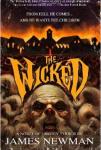
James Newman
Shock Totem Publications
Trade Paper, 352 pages, $14.99
Review by Sheila M. Merritt
Remember the witticism “Nostalgia isn’t what it used to be?” If so, then you are old. Seriously, feeling nostalgic for a bygone era is human and healthy; and can be applied with an emphasis on horror fiction. In genre terms, the 1980s is remembered for horror writing saturating the publishing market, and the onslaught of material causing the bubble to burst. Was it too much of a good thing, or too many bad attempts to jump on the bandwagon? The answer is yes. In The Wicked, James Newman blatantly gives a shout out to the cultural period which bestowed fad fame on big hair, and large shoulder pads in dresses and blouses. The author’s unbridled enthusiasm for the aesthetics of the epoch is echoed in his narrative. Indeed the novel’s frailties are rather trumpeted as part of its charm. Its reverence for the flaws of the era is disarming, and makes it hard to diss the book on many levels. That said, The Wicked indeed reflects the time it holds so dear. Like the aforementioned overblown hair and exaggerated clothing, Newman’s novel is a quintessential example of 1980’s excess: A guilty pleasure, to be sure.
The plot is an homage, which parenthetically means “this has been done before.” A couple leave New York City after the wife is raped while walking home alone. Moving to North Carolina with their adorable seven-year-old daughter, the spouses can’t shed the trauma; pregnancy has occurred within the interval of the assault, and paternity is uncertain. The husband requests testing be done, but his religious mate refuses. A difficult household dynamic is thus established, letting the reader know that no matter where this duo may choose to live, there is a conflict hovering. Not unexpectedly, their residence choice provides added intensity to the relationship’s simmering volatility. The town is the scene of a tragedy: A fire destroys The Heller Home for Children, killing kids and their caretakers. The arsonist/murderer is presumed to be crazy, and the townsfolk are spooked by the act and the perpetrator. But the lad who set the blaze is merely the instrument of an ancient evil – no spoiler alert necessary.
The demon who sets the chaos in motion is one dastardly dude. And he ain’t pretty: “The demon’s beard was matted and crawling with vermin. Flies swarmed about his huge, misshapen head like a halo of pestilence. The creature’s eyes were black as coal, yet at the same time they seemed to glow with an otherworldly light. His nose was long, sharp, and bird-like, his teeth crooked and stained with something that looked like mossy green fungus.”
Reactions to the deeds of the nasty entity aren’t strong in verisimilitude. Even after a character points out similarities to the film The Invasion of the Body Snatchers neither he nor the person to whom he speaks seems to think it’s a good idea to get out of Dodge. And when odd turns into aberrant, there’s a loosey-goosey approach to monitoring those exhibiting the wacko attributes. Again, this is all part of the author’s plan. He’s playing with stylistic stereotypes and having a grand old time.
James Newman says in the book’s afterword, “The Wicked is my ode to the stories I grew up with. The over-the-top, demented, but most importantly fun horror novels that were all over the place when I was a teenager, for better or for worse.” That quite sums up the tale. It is loopy and gory and sexually explicit. And has plot holes and character motivation that don’t survive scrutiny. Yet, it does succeed in what the author considers of paramount importance: it is a “fun” horror novel. Invoking the thematic atmosphere of a significant period in horror fiction, The Wicked triggers fond memories.









Trackbacks/Pingbacks